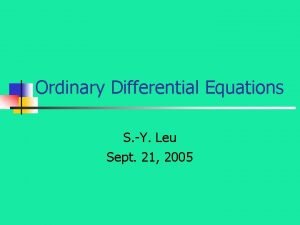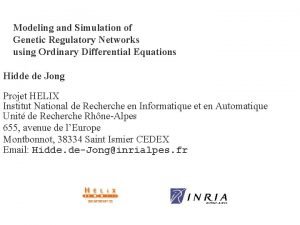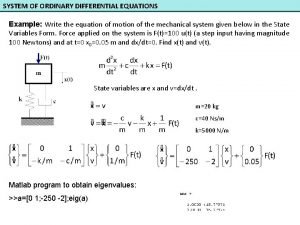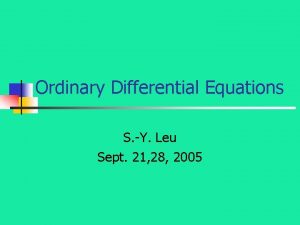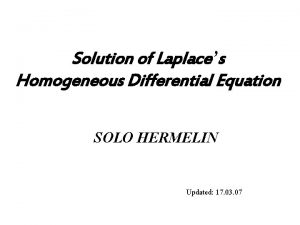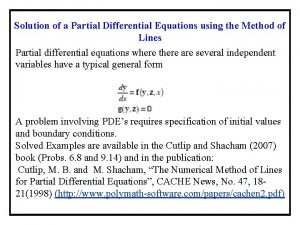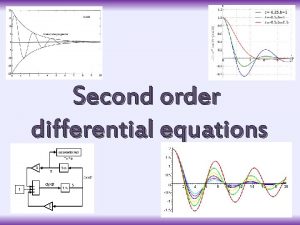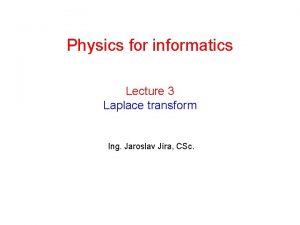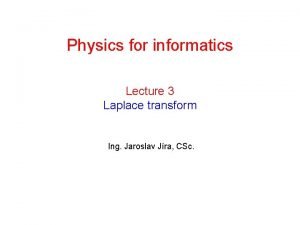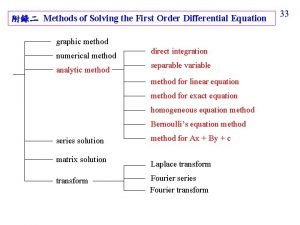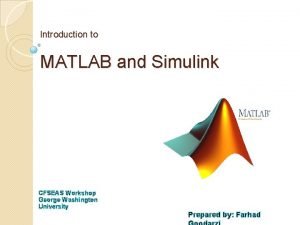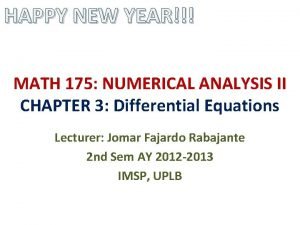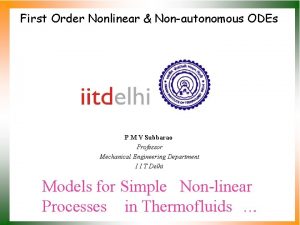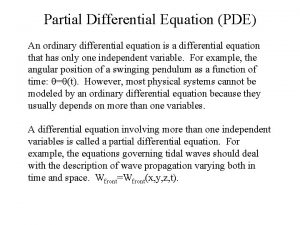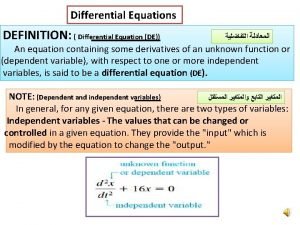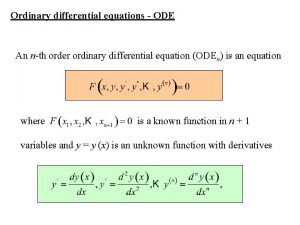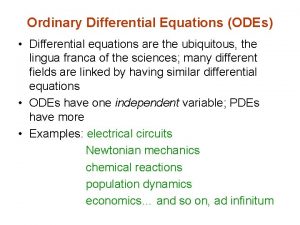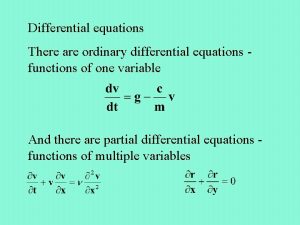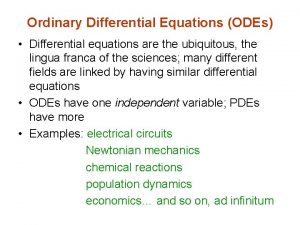Using the HawkDove Model and Ordinary Differential Equation


























- Slides: 26

Using the Hawk-Dove Model and Ordinary Differential Equation Systems to Study Asian Carp Invasion Yvonne Feng and Kelly Pham

Outline �Background �Motivation �Introduction to our models �Different Invasion Problems �Limitations of our models �Future Work

Background �Native habitat: China �Prolific (spawns rapidly) �Eats plankton �Eats approximately 6. 6 -11. 3% of their body weight



Invasion Problems �Asian carp introduced to US in 1970’s �Migrated to Mississippi River �Competes with native species for food � 50% of total catch in 2008 �Currently threatening the Great Lakes

Why Research This? �To study and understand the interaction between the native and invasive species �To study the speed of the invasion with aims to identify parameters to slow down or to stop the invasion

Game Theory Model �Hawk-Dove as basic model �Represent it as an ODE system (normalized) �Choose V = 2 and C = 4

Diffusion- Reaction Model �Divide river into n cells and add spatial component �Formula: ∂w/∂t = F(w) + D∆w �w is the 2 n x 1 vector that represents the population fractions in each cell �F is the change of population fractions over time in each cell (our ODE model) �D∆ is the 2 n x 2 n matrix that contains the Laplacian matrix and the diagonal matrix of diffusion coefficients

La Crosse Davenport Initial Conditions (Carp) : w 0 =(0. 2, 0. 1, 0) Saint Louis Carp Native Fish Carp -1 2 Native Fish 0 1

Population Fraction of Asian Carps Plot of Asian Carps Population in Cell r at Time t Tim e. S tep (Ch ose n a uto ma tica lly by ma tlab ) Cel h ce c a e ( l# ll re nt a prese spo riv e h t t in er)

Modeling the Implementations �Electric Fence �Change diagonal entry of coefficient matrix to 0. 000001 �Targeted Removal �Add matrix to payoff to matrix A for the cells where targeted removal is happening


Problems �Asian Carps are introduced in certain spots in the river �Asian Carps heavily invade the entire river

Assumptions �Fish in each spot is either an Asian carp or a native fish �All carps act like Hawks; all native fish act like Doves �Total biomass in each spot is conserved �The carrying capacity of the river is constant �Fish dispersal is independent of temperature, amount of food, flow

Problem: Prevent Future Invasion �Asian Carps are introduced in cell #1 -3 �(ex. Cell 1: 025, Cell 2: 0. 1, Cell 3: 0. 05) �Electric Fence: 16 million dollars each �Targeted Fishing: 2 million dollars each set �Goal: Find the best fishing strategy to prevent Asian Carps from invading into other areas(Cell 4 – Cell 10)

Population Fraction of Asian Carp Results 0. 6 Beginning of Invasion: Final Population Fraction of Asian Carps 0. 5 No Treatment 0. 4 0. 3 0. 2 Fence between Cell #3 and 4 0. 1 Fish Cell 4 7 0 Cell 1 Cell 2 Cell 3 Cell 4 Cell 5 Cell 6 Cell 7 Cell 8 Cell 9 Cell 10

Discussion �If the Targeted Fishing is as good as our assumption, with the given initial Asian Carps Population Fractions: �Fishing Strategy: Cell#4 -7 ü Least Population of Asian Carps that invade cell #4 to 10 üMore Money efficient than implementing Electric Fence


Problem: During Invasion �Random Asian Carps Initial Population Fractions �Resources: 2 sets of targeted fishing �Average Invasion Index: Average of the sum of Asian Carps Population after targeted fishing over 20 iterations

#1 Group of Targeted Fishing in Cell# Average Invasion Index of 20 random Asian Carps Initial Conditions #1 Group of Targeted Fishing in Cell#

Discussion �Putting all of the targeted fishing groups in one cell is a bad strategy �With the current 20 random initial Asian Carps population iterations, and given two groups of targeted fishing: results suggest that placing the two fishing groups in separate cells between the center and end of the invasion domain is a good strategy

Limitations �Native and invasive fish interactions are most likely more complicated than represented in the Hawk-Dove mode �Most likely, there will be a change in biomass �In addition to fish dispersal, fish also exhibit active movement towards food sources and favorable environmental conditions

Future Work �Add a Retaliator to our Hawk-Dove model �Incorporate a term for active movement of fish �Reassess results for later time points

Thank you!

Any Questions?
 Nonlinear ordinary differential equations
Nonlinear ordinary differential equations General solution of ode
General solution of ode Ordinary points
Ordinary points Differential equations
Differential equations Bernoulli differential equation ppt
Bernoulli differential equation ppt 1st order derivative formula
1st order derivative formula Ordinary differential equations example
Ordinary differential equations example Singular solution of ode
Singular solution of ode What is euler's equation
What is euler's equation Partial differential equations
Partial differential equations Non homogeneous differential equation
Non homogeneous differential equation Exponential differential equation
Exponential differential equation Slidetodoc.com
Slidetodoc.com Homogeneous differential equation
Homogeneous differential equation Pde solutions
Pde solutions 2nd order homogeneous differential equation
2nd order homogeneous differential equation What is f(0)?
What is f(0)? Laplace transform shift
Laplace transform shift Differential equation basics
Differential equation basics Integrating factor method
Integrating factor method First-order differential equations
First-order differential equations Find the general solution of the differential equation
Find the general solution of the differential equation Calculus equations
Calculus equations First order circuit
First order circuit Dot product matlab
Dot product matlab Equation of happy new year
Equation of happy new year Autonomous ode definition
Autonomous ode definition
